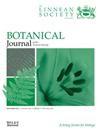Plant extinction in the Anthropocene
IF 2.2
2区 生物学
Q2 PLANT SCIENCES
引用次数: 0
Abstract
Species go extinct each day, most without notice. The current human-induced extinction rate is up to 700 times higher than the background rate. Extinctions are not different for plants, animals, or fungi, although botanical and invertebrate extinctions are much more poorly documented than those of charismatic vertebrates. In a recent book on extinct plants (Christenhusz & Govaerts, 2023), an overview of botanical extinctions since 1753 was presented, listing which species became extinct and the probable reason for their extinction. As most have a date when they were last documented, a timeline of extinction can also be compiled based on these data. This timeline shows an increase from 1890 to 1940, but a decline in new recorded extinctions after the 1980s, which is likely a result of taxonomic impediment. Extinction rates before 1800 are impacted by the lack of data (here named Berkeley extinction). It can be concluded that extinction is highest in biodiversity-rich areas with high human influence (extinction hotspots). Two new combinations and a new name are proposed here, showing the importance of taxonomy to conservation. Although anthropogenic plant extinction is a global phenomenon, areas of particular concern are the Hawaiian Islands, southern Africa, Australia, the Indian Subcontinent, Southeast Asia, and Brazil. Extinctions have been mainly caused by land clearing for agriculture and urbanization, invasive feral animals, mining, river dams, diseases, and poaching. We predict that the unusual weather patterns associated with rapid climate change may result in more plant extinctions. Reintroduction, even if a species persists in cultivation, is not always possible due to lack of suitable remaining habitat where threats are decreased or removed. Successful reintroduction cannot be guaranteed. It is costly and usually dependent on short-term funding, after which these efforts may be in vain. Protection of species in their natural habitat is much more cost-effective in the long term. Sometimes, rescued plants should be introduced in similar habitats outside their natural range where the threats are absent. This follows the programmes of assisted migration for climate change mitigation, but this can also be assisted introduction to prevent extinction. Protection of critically endangered species that have naturalized outside their native range should also be considered.人类世的植物灭绝
每天都有物种灭绝,大多数都是在不经意间。目前,人类造成的物种灭绝率是背景灭绝率的 700 倍。植物、动物或真菌的灭绝情况并无不同,不过植物和无脊椎动物的灭绝记录要比有魅力的脊椎动物少得多。最近一本关于已灭绝植物的书(Christenhusz & Govaerts, 2023)概述了自 1753 年以来植物的灭绝情况,列出了哪些物种灭绝以及灭绝的可能原因。由于大多数物种都有最后记录的日期,因此还可以根据这些数据编制一个物种灭绝时间表。该时间表显示,从 1890 年到 1940 年,物种灭绝率有所上升,但 20 世纪 80 年代后,新记录的物种灭绝率有所下降,这可能是分类学障碍造成的。1800 年之前的灭绝率受到了数据缺乏的影响(此处命名为伯克利灭绝)。可以得出的结论是,在生物多样性丰富且受人类影响较大的地区(灭绝热点),物种灭绝率最高。这里提出了两个新组合和一个新名称,显示了分类学对保护的重要性。尽管人为植物灭绝是一个全球现象,但夏威夷群岛、非洲南部、澳大利亚、印度次大陆、东南亚和巴西等地区尤其值得关注。造成植物灭绝的主要原因包括:为农业和城市化开垦土地、野兽入侵、采矿、河坝、疾病和偷猎。我们预测,与快速气候变化相关的异常天气模式可能会导致更多植物灭绝。在威胁减少或消除的情况下,由于缺乏合适的剩余栖息地,即使某个物种在栽培过程中存活下来,也不一定能实现重新引入。不能保证成功重新引入。重新引入的成本很高,而且通常依赖于短期资金,之后这些努力可能会付诸东流。从长远来看,在自然栖息地保护物种更具成本效益。有时,应将获救植物引入其自然分布区以外的类似栖息地,因为那里不存在威胁。这是为减缓气候变化而实施的辅助迁移计划,但也可以通过辅助引种来防止物种灭绝。还应考虑保护在原生地以外归化的极度濒危物种。
本文章由计算机程序翻译,如有差异,请以英文原文为准。
求助全文
约1分钟内获得全文
求助全文
来源期刊
CiteScore
5.70
自引率
8.30%
发文量
54
审稿时长
3.5 months
期刊介绍:
The Botanical Journal of the Linnean Society publishes original papers on systematic and evolutionary botany and comparative studies of both living and fossil plants. Review papers are also welcomed which integrate fields such as cytology, morphogenesis, palynology and phytochemistry into a taxonomic framework. The Journal will only publish new taxa in exceptional circumstances or as part of larger monographic or phylogenetic revisions.

 求助内容:
求助内容: 应助结果提醒方式:
应助结果提醒方式:


